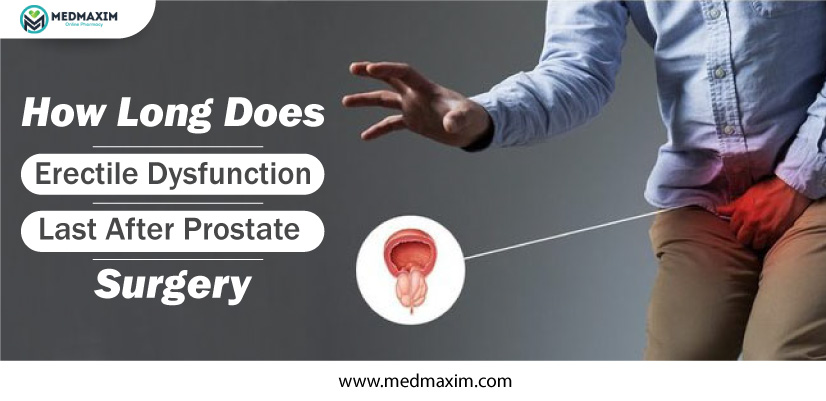Regardless of the type of prostate surgery, some probable side effects are bound to occur that affect patients’ quality of life, at least for the first few months after the treatment. With the surgery, the consequences can be particularly concerning to those who are trying to ascertain exactly which approach is suitable for them. This complex surgery irrespective of the method or other treatments followed may influence a patient’s sex life, causing challenges like low libido, erectile dysfunction, dry orgasm, or low sperm count. However, according to medical experts, most of these side effects can be managed as a result. There is the possibility of reviving the sex life to its highest potential after the proper treatment.
Unfortunately, erectile dysfunction is a possibility for almost all the treatment options regarding prostate surgery. The severity of dysfunction revolves around many factors, including the patient’s overall health, inherent medical conditions, and the ability to sexual function before treatment.
According to researchers, men having trouble achieving erections post-prostate surgery usually show improvements in sexual function within 2 years after the surgery.
Erectile Dysfunction And Its Causes
The penile shaft is composed of three erectile columns, the erectile tissues (corpora cavernosa and corpus spongiosum), dorsal nerves, lymphatics, and blood vessels, all covered by skin. An erection is achieved when the brain sends sexual arousal signals to the nerves in the penile. The nerves in turn signal blood vessels in the penile to expand such that abundant blood flows through the penile and makes it erect.
Due to some enzymatic activity in the smooth muscle walls of the penile blood vessels. The proper supply of blood in the penile is hindered. Erectile dysfunction may also result post-surgery when the nerves that are in charge of sending the signal to the penile get damaged or injured. As a result, men may find it difficult to attain or sustain a natural erection for indulging in sexual intercourse.
What Is Prostate Surgery Done For?
The prostate gland is located just below the bladder in men and surrounds the top portion of the tube that drains urine from the bladder or urethra. It plays a primary role in the part of the male reproductive system that produces fluids that nourishes and transports seminal fluid (sperm).
Prostate surgery also known as a prostatectomy involves partial or complete removal of the prostate. The most common causes of prostate surgery are prostate cancer and an enlarged prostate or benign prostatic hyperplasia (BPH).
In addition, prostate cancer tends to be slow-growing cancer. Surgery may be a good option if the cancer is contained in the prostate gland. The ultimate goal of this surgery depends on your condition. For instance, prostate cancer surgery is done to remove cancerous tissue while the goal of BPH surgery is to remove prostate tissue and restore the normal flow of urine. Surgery is also dependent on age, overall health, and other factors.
In case you have been diagnosed with either of these two conditions then you might want to know how to restore your sexual function or what options are available for its effective treatment after the surgery. The first and foremost thing to do is to talk openly with your doctor as getting yourself acquainted with the pretreatment education would help make decisions.
Since all types of prostate surgeries are done with general anesthesia that would make you unable to feel pain during surgery by putting you to sleep or spinal anesthesia. Which numbs only the lower half of your body. Your doctor would recommend a type of anesthesia depending on your situation.
Types Of Prostate Surgeries
There are three types of prostate surgeries: Radical prostatectomy, transurethral resection of the prostate (TURP), and pelvic lymphadenectomy. Let us have a look at them one by one.
Radical Prostatectomy
This type of surgery is beneficial for men with prostate cancer whose health is otherwise in good order. However, this surgery carries a risk as there are two tiny cavernous nerves located along the sides of the prostate gland. Normally, these cavernous nerves are responsible for carrying signals to the penile to fill with blood and become erect.
During the surgery, the doctor may need to remove one or both of these nerves in case they are in proximity to cancer. Chances are, even if the nerves are not removed. They can still get damaged during the surgery. Injury to the cavernous nerves is one of the main causes of erectile dysfunction after the surgery.
Types of Radical Prostatectomy
- Retropubic Prostatectomy
The prostate is removed through an incision in the wall of the abdomen. To reduce the risk due to the spreading of cancer cells, nearby lymph nodes are also removed through the same incision.
- Perineal Prostatectomy
The prostate is removed through an incision in the region between the testicles and the anus. They might also remove the lymph nodes by using a separate incision in the abdominal wall.
- Laparoscopic Prostatectomy
The surgeon may make five or six incisions in the abdomen to remove the prostate. This procedure is usually performed by hand, using a camera and a lighted tube that serves to guide surgeons.
- Robotic Prostatectomy
This type of surgery involves the surgeon using a computer to control a robotic machine with four arms. They perform a laparoscopic procedure.
Common Side Effects Of Radical Prostatectomy
Some potential risks may include bleeding, injury to nearby organs such as bowel and nerves, blood clot formation, and infection. The most common side effects are urine leakage, also known as urinary incontinence, and erectile dysfunction.
Transurethral Resection Of The Prostate (TURP)
This type of surgery does not cure cancer instead it involves cutting away a section of the prostate. It helps to resolve difficulty passing urine. This usually happens when the enlarged prostate presses against the bladder, causing it to become narrow.
It involves a surgeon passing a thin metal tube with a camera attached through the penile to the urethra. The surgeon then inserts a small wire loop through the tube and applies heat to detach small parts of the prostate tissue. In between the operation. They will also pass fluid through the bladder to flush away the removed tissue.
Common Side Effects Of Transurethral Resection Of The Prostate
After the surgery a person may experience retrograde ejaculation meaning, the semen flows into the bladder instead of out of the penile. After this men may not be able to father a child through sex. Other side effects of the surgery include erectile dysfunction, urinary incontinence, and urethral stricture.
Pelvic Lymphadenectomy
This type of surgery helps doctors to check whether more intensive surgery is necessary and plan further treatment. It is done to check for cancer in the lymph nodes in the pelvis and see how many lymph nodes are affected due to cancer. Next, they remove the affected lymph nodes and also some other lymph nodes that are prone to cancer and send them for biopsy. By doing so, they will make sure that they prevent more damage by recommending different treatments.
To Conclude
Studies have shown, within one year after treatment, nearly all men with intact nerves will see a substantial improvement. Within that period one can make use of ED treatment alternatives such as prescription medicines, mechanical devices like vacuum devices or penis pumps, and surgical options. It is necessary to consult your doctor for helping you to choose the most suitable option for effective treatment of erectile dysfunction as they can recommend a beneficial solution according to your condition.





